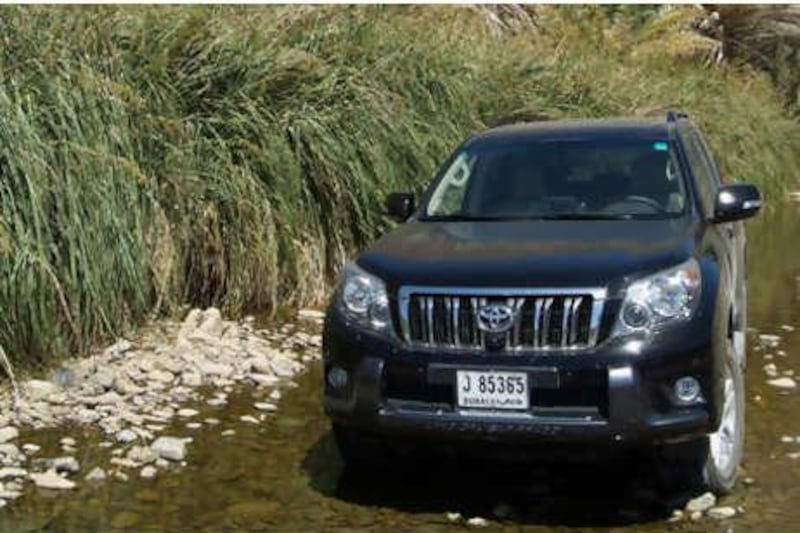The summer heat may be in full swing, but an off-road destination with fresh running water pools and lovely cool shade is beckoning in Wadi Jazira. For several years I've saved this trip for when the heat becomes intense, because that is the time you really appreciate the deep gorges and waterfalls. Plus, in winter, the water is so cold I can't bring myself to get in. With an air-conditioned vehicle, Wadi Jazira is a cinch to visit - and since I'm at the wheel of a Toyota Land Cruiser Prado, with tinted windows and a powerful a/c system, I took a small detour to Fossil Valley on the way, not worrying about the heat.
Wadi Jazira is one of the wadis that seems to have water running all year round, and it is just outside Buraimi, in Oman. To enter from the Al Ain Hili border post (waypoint 1), a visa is not required - all you do is present your passport with valid GCC visa - but please check that your car insurance covers the Buraimi area in Oman. The car insurance issued in Al Ain usually does this automatically, but perhaps in other UAE cities this does not apply.
View Jazira June 2010 in a larger map
Once across the border post, take an immediate left at the roundabout, and you will be heading along the border fence. Keep an eye out for a large apartment complex to your left, on the UAE side, and just as that ends, take the turn to the right, next to a bright, peach-coloured villa, and then a lovely white mosque. At the next roundabout (waypoint 2) take the right exit and proceed a couple of kilometers to a very large roundabout (waypoint 3), where you will turn left towards Sohar.
At the next roundabout (waypoint 4), take a left sign-posted to the town of Mahdah, and you are now in open country, cruising through the Omani rocky hills on a single-lane strip of tarmac. After a particularly twisty section, you will come out into a wide-open plateau, and on your right will be tracks leading towards the distant hills. This valley is known to many expats as Fossil Valley, due to the collapse of a large escarpment, which revealed plentiful fossils of ancient sea life. It is a very popular spot, and hence I severely doubt you will find anything interesting; however, sea shell fragments and the occasional fossilised shark tooth are a thrill to find, especially for the kids.
From the tarmac (waypoint 5), take any of the tracks leading right and to the far back of a horseshoe-shaped valley, and you will see several good spots shaded from the morning sun. The valley itself is a treat to cross, as it collects rainwater from all the surrounding hills, making it a fertile grazing ground for goats and camels, and even wild donkeys. When we passed through, the grasses were still green and the ground was covered with wild flowers (waypoint 6).
At the collapsed escarpment (waypoint 7), we let the kids scamper all over the place. We had desert-wise kids with us, otherwise we would have taken the time to instruct them how to pick up rocks in the desert: find a short stick and use it to prise up rocks, twigs and any other objects. Only then, once you have seen for certain that there is not a scorpion or other creepy-crawly under it, can you pick it up with your hand.
We returned to tarmac along the northern hill range, and soon were on our way to passing the town of Mahdah: a historically important area, at the feet of mountains, and a quick stop to wander around the old part of town is worth enduring a little heat. We stopped at waypoint 8, on the edge of the old oasis, looking across it to the fort (waypoint 9). From Mahdah, take the main tarmac road as it winds around the mountains to the right, making a wide semi-circle. You will now be driving parallel to a wild mountain range to your left, which is your destination. You will know when to turn left by looking for the road sign to Al Khabbayn and the presence of a small brick bus/taxi shelter at the turn-off (waypoint 10).
Once heading straight towards the mountains, still on tarmac, look for a small sign pointing to a left turn-off (waypoint 11), which dips into the wadi and then back up again - follow that road and it will abruptly turn into a hard dirt track with a large sign pointing towards Wadi Jazira (waypoint 12). Reduce your speed for sharp turns and steep climbs. (waypoint 13). Follow that track until you will see, in all its splendour, a tight valley completely filled with lush green vegetation: our destination.
In our days of tap water and plumbing, we've taken having water for granted, but even as early as 20 or 30 years ago, can you imagine coming over that ridge with your tribe and animals to this sight? Is that not deserving of being called paradise? Today, it is open access to all visitors. Please make sure you return the villagers' kind hospitality by being an exemplary guest, remaining modest and leaving no trash whatsoever.
At the intersection (waypoint 14), right will take you around and upstream, to the small dam and its reservoir; and left will take you downstream, parallel to the gorge. I suggest you first visit the dam briefly at the start of the gorge (waypoint 15), and then drive back to the very end of the gorge (waypoint 16) where you can park and walk upstream into the gorges themselves. If you have people with you who cannot or will not climb up small waterfalls, then I would park just left of the intersection and access the gorges from there (waypoint 17).
From the very bottom of the gorge, to move your car off the track and onto the stones, engage low gear and allow the car to slowly crawl over the smooth rocks. The Toyota has a rock-crawling mode that maintains the speed you set with the turn of a dial - it made traversing the terrain too easy for me, so I switched it off to enjoy the challenge. Basically you are looking to get close to the flowing water and shade, so that you do not have to carry cool boxes and chairs very far. If you have nothing to carry, then simply walk up the canyon until you reach water.
There were perhaps a dozen waist-deep pools on our visit, most of them separated from each other by a gentle waterfall. As you get deeper into the gorge, it closes in over you, and the erosion from the force of the water rushing through the narrow passageway has formed wonderful tunnels and shallow caves. The climbs get more difficult, until you arrive at a wall with delicate black and white markings of leached mineral deposits. At that point we could not get up the next waterfall, and indeed it is the last one before the gorge opens up and the stream runs along the surface, and the same damis in front of you.
On the way back, you can take a more direct route, heading left once you reach the outer tarmac road, and then swinging right at the first intersection (waypoint 18) and then right again through a cut in the mountains (waypoint 19) and then straight all the way to the border post. Next month, we take a day trip to Hijer Bani Humayd near Masafi and end up at the beach for an evening swim. motoring@thenational.ae






